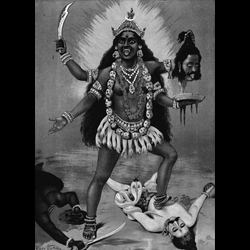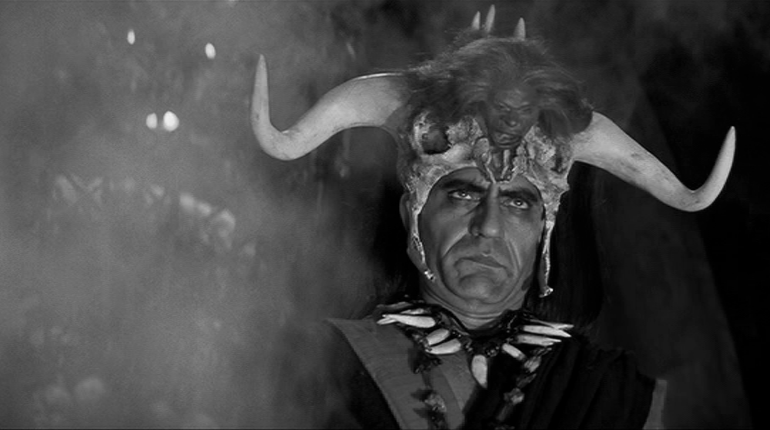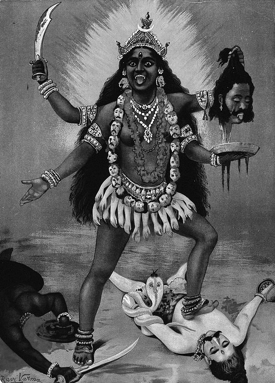
Among the unreleased Mordor tracks, “The Black Priestess of Kālī” – alternatively titled “La Sombre Servante de Kâlî” – is an unlikely mix of ethnic inspired music and industrial symphonic metal, including female lead vocals, French lyrics and some Sanskrit words. It is part of a trilogy dedicated to the Hindu goddess Kālī, also comprising the songs “Mahārātrī” and “Chants à Kâlî”.
“The Black Priestess of Kālī” was poorly recorded hardly in stereophony in 1997 on a 2-track tape during a private live act at La Dolce Vita, formerly a famous alternative music club in Lausanne, Switzerland. Even tough the many sound and performing imperfections due to live situation may cause some trouble for the listener to recreate in himself the original Idea of the song, this version is the only historical vestige of a piece having a peculiar place in our musical repertoire.
To serve the narrative of the track, the music video features notably pictures of authentic Hindu art and documents, but also a distorted dance scene from 1934 film House of Mystery and 19th-century works from Westerners illustrating their (mis)perception of India, Thuggee and Kālī’s cult.
The lyrics of the song are a sinister hymn in praise of the dark divinity, with various possible interpretations. It is based on the viewpoint of a Kālī’s fictional female devotee, member of a Śākta movement – Hindu goddess-focussed tradition – and also inspired by the Thugs, a secret fraternity of robbers who worshipped Kālī and were renowned for their numerous ritual murders. However, some modern scholars seriously debate about the real existence of a Thuggee cult in the 19th century, believing that it was in fact partly the product of British colonial imagination and fears, used for extending control on the populations of India with brutal repression and to justify the “civilizing mission” of the colonizers.
Exaggerated representation of Thugs as followers of an evil cult was frequently exploited in literature (Confessions of a Thug…) and later in cinema, the best known example being likely Indiana Jones and the Temple of Doom. Thus in the film Mola Ram, the high sacrificial priest of Kālī, declares:
“The British will be slaughtered. Then we will overrun the Muslims. Then the Hebrew god will fall. And then the Christian god will be cast down and forgotten. Soon Kālī Mā will rule the world.”

In his vindictive project, he equates thus Kālī’s cult, anti-colonialism, fight against Abrahamic monotheisms and desire to dominate. This is a good example of “accusatory inversion” and anti-Hindu bias, for historically it is in fact rather Abrahamic universalistic religions and materialistic ideologies stemming from modernity that have tried violently or insidiously to impose their views on Hinduism, one of the last pagan citadels under siege.
Moreover, Mola Ram whose name is a juxtaposition of mullah and Rāma, a Viṣṇu’s divine avatar, does not seem to know that a part of Thugs was of Muslim origin, perhaps Ismaili Nizaris, connecting Kālī to Fatimah, the daughter of the Prophet, and that Thuggee religious aim was not global hegemony but sacred service to preserve world from destruction or to avoid excessive proliferation of life on earth and dominance of the creative power over the destroying one.
According to ethnographic fiction Confessions of a Thug, the two powers conflict with one another from the beginning but are emanations from the Supreme Being, which has some similarity with ancient Iranian Zurvanism and the doctrine of the “twin brothers”, sons of the great androgynous god Zurvan “Time”. It is representative of a philosophical conception both ditheistic, with two powers opposing each other, and monist, because they are generated by a First Principe. In any case, Mola Ram’s statement is certainly more indicative of the ideology in action behind the movie and its appointed enemies than of Thugs’ real worldview.
The exact religious status of the Thuggee cult – if it has actually existed – inside Hinduism is difficult to determine precisely: emphasis is placed on ritual sacrifice, there is evidence of initiation ceremony and guru, but despite the importance of Kālī, it was not directly part of Śākta traditions or Tantric Left-Hand Path (Vāmamārga), and its devotees did not appeared to try to reach mokṣa, the spiritual liberation, but to keep a balance between the creative and destroying powers, in serving the latter. Nevertheless, as the Tantric hero (vīra) has often to go through extreme experiences, we would say that there is at least one common ground between the two paths.

As for Kālī’s iconography, the lyrics of “The Black Priestess of Kālī” should be not interpreted only literally, but rather symbolically: what we must sacrifice are our ego (the “false I”, a temporary knot in opposition to the Self), countless illusions, fears and conditionings. Life is both tragic and ridiculous, death is inevitable for all beings and according to Schopenhauer, is “the true inspiring genius, or the muse of philosophy”, but Kālī may be the death of death, because as Ādyā Kālī “Primordial Kālī”, She is the devourer of Kāla “Time” and the original form of all things. One of the higher goals of sādhanā (spiritual practice) is to achieve identity between the worshipper and the deity, while being aware that it is difficult to reach it.
A line from a poem by Śārikā Devī said: “Your ultimate destiny is the cremation ground; do not forget your true identity”. It is important to fully realize the physicality of death, as we tend in modern societies to avoid it and to forget that we are mortal beings. Therefore for a radical Left-Hand Path follower, when possible the ideal place to learn about death is the charnel ground, by being confronted with the impermanence of all things, carrion feeders, spirits of the deceased, and those attracted by miasma (spiritual pollution). As the Aghori Vimalānanda told to Robert E. Svoboda:
“The worst fear of all is the fear of death; once you go beyond the fear of death, you go beyond all fears because you go beyond expectation and anticipation which are the causes of most karmas […] When death has no value for you, time loses its value, and then you don’t bother about anything.”
“Dancing mad with joy,
Come, Mother, come!
For Terror is Thy name,
Death is in Thy breath,
And every shaking step
Destroys a world for ever.
Thou ‘Time’, the All-Destroyer!
Come, Mother, come!
Who dares misery love,
And hug the form of Death,
Dance in Destruction’s dance,
To him the Mother comes.”
Excerpt from the poem “Kālī the Mother” (1898) by Svāmi Vivekānanda.
“The Black Priestess of Kālī” is dedicated to काली.
Mordor were at the time of this recording:
Flore de la Mandragore – female voice
Scorh Anyroth – voice, guitar, machines, sounds
Dam Gomhory – bass, machines
S3th – guitar
Farkás – drums & percussion
H. G. – visuals
Music and words by Scorh, 1997.
Music video by Vorknasor/Scorh/Dam, 2018.
